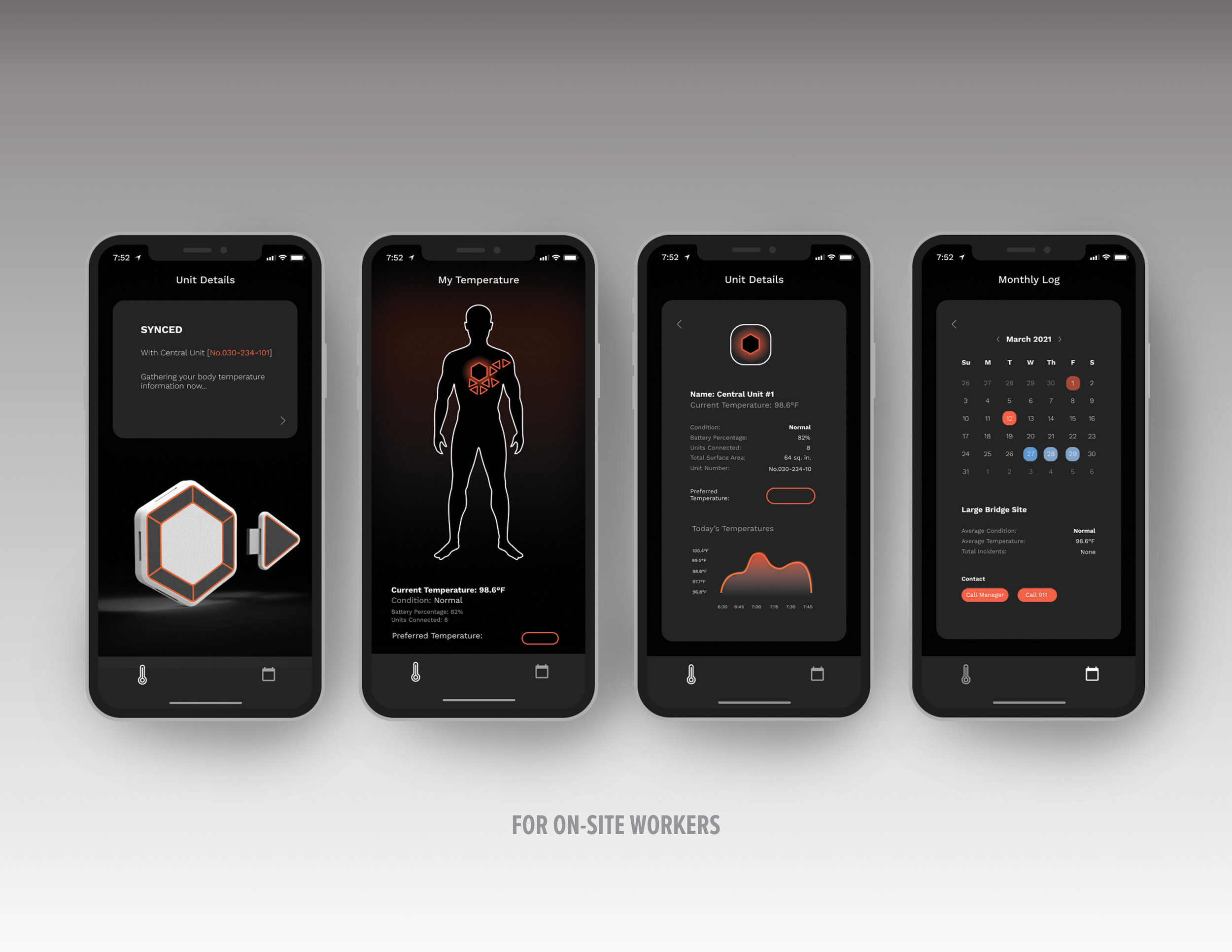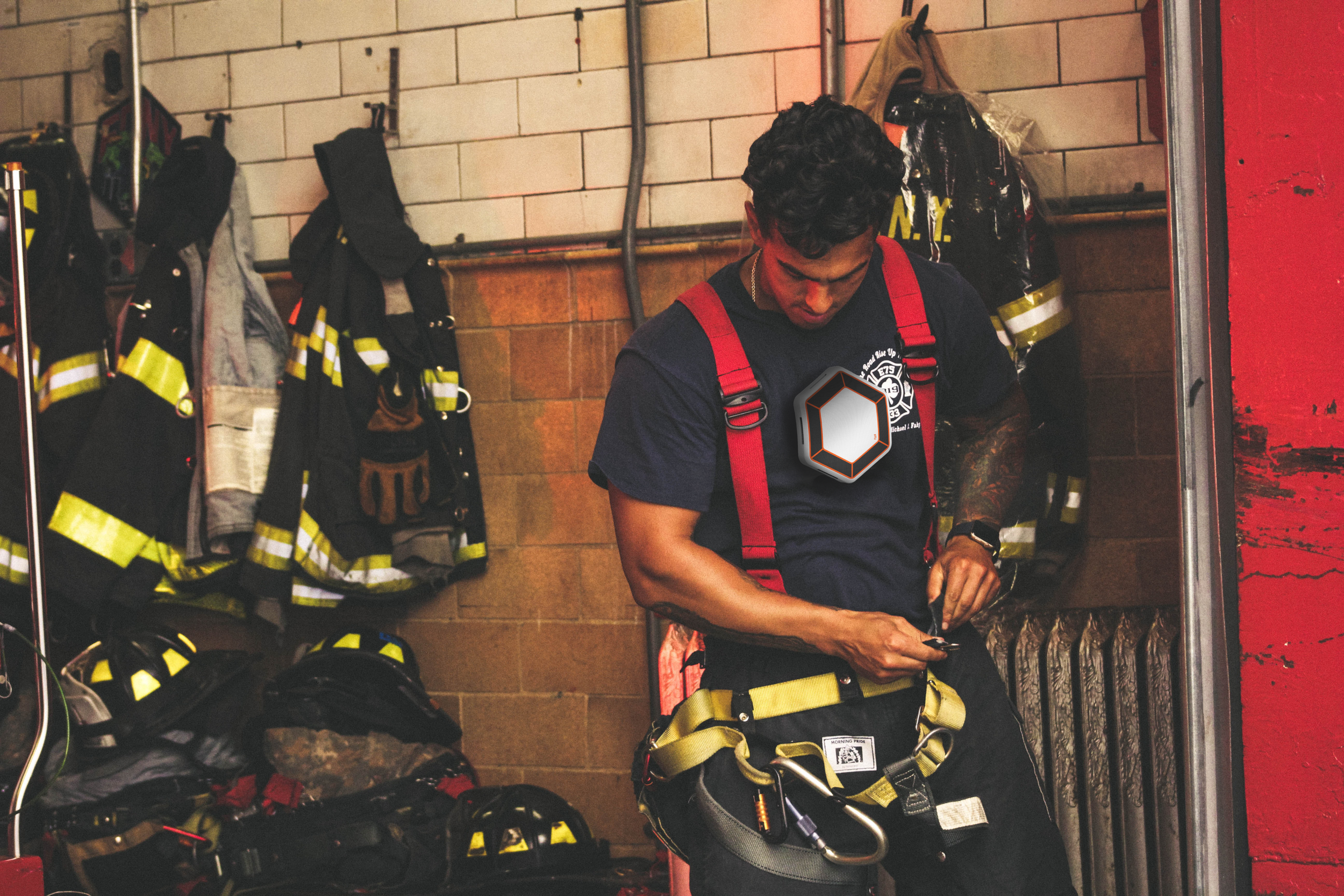
Flux
A modular IoT system of temperature monitoring and regulating wearables for blue collar industry workers.
Discipline
Industrial design,
User experience,
Interface design
Duration
10 weeks
(March - June 2020)
Team
Solo

According to the U.S. Bureau of Labor Statistics, “Exposure to environmental heat led to 37 work-related deaths and 2,830 nonfatal occupational injuries and illnesses involving days away from work in 2015.”
The Problem
The U.S. Occupational Safety and Health Administration’s (OSHA) accident records also contain summaries of thousands of temperature-related incidents: lumberjacks passing away from hypothermia, roofers suffering from heart attacks due to heat exhaustion, etc.
Impacted Industries
Blue collar jobs are typically classified as involving manual labor and compensation by an hourly wage. Some fields that fall into this category include construction, manufacturing, maintenance, and mining.
Workplace Requirements
work in direct sunlight (adds up to 15 degrees to heat index)
work in variable weather / climates
perform prolonged or strenuous work
wear heavy protective clothing or impermeable suits
prolonged exposure to heat-generating appliances
Potential Risks
heat stroke
heat exhaustion
heat cramps
heat syncope
heat rash
rhabdomyolysis
hypothermia
frostbite
trench foot
The Current System
“Under OSHA Law, employers are responsible for providing workplaces free of known safety hazards.”
This includes protecting workers from extreme temperatures.
Following OSHA guidelines, an employer should establish a “complete heat illness prevention program”:
provide workers with water, rest, and shade
allow workers to gradually acclimate to heat
plan for emergencies and train workers on prevention
monitor workers for signs of illness
However, there is no standard for how an employer should monitor or document this information.
Existing Solutions
For Employers + Managers
Extech Heat Watch
Heat, humidity, heat index, timing functions
No data logging function
Small, portable
Thermal Cameras
Visualize and measure body heat
No data logging function
Likely not in constant use
For Workers
Evaporative Cooling Bandana
Simple, inexpensive
Easy to wear under gear
Not effective for whole body use
Thermoelectric Gear
Individual components
Battery powered
Limiting / not adaptable
Current State
There are no standardized tools, monitoring systems, or documentation practices to ensure worker heat safety, across a variety of blue collar industries.
Overall Limitations
Inability to monitor workers unless at close proximity
Lack of documentation function
Current State
Besides personal protective gear and high-visibility vests, uniforms are not consistent within same profession.
Overall Limitations
Inability to regulate both temperature extremes
Inflexible solutions
Limited by specificity of wearable type
User Personas
Name, Age
Steve, 38
Occupation
Construction
Behaviors
Loads and unloads materials, tools, and equipment
Assists transport and operation of heavy machinery and equipment
Pain points
Extreme, sometimes unexpected temperature / weather variation
Dresses warmly for early morning start, but ends up overheating later
Unsure when / at what point physical discomfort requires attention
Name, Age
Tom, 43
Occupation
Behaviors
Manages several sites at once
Uses different software and connected devices to monitor information (e.g. Extech 42270)
Project manager
Pain points
Many logistical metrics to track; time-consuming and overwhelming
Difficult to monitor health / safety of individual workers
Lack of temperature monitoring, regulation, and awareness practices at job sites + variable climate conditions put blue collar workers at greater risk for temperature-related illnesses.
01
02
We should build...
a versatile product for blue collar industry workers to easily regulate their body temperatures while working in harsh, variable climates.
a system for blue collar industry employers to efficiently monitor and document workers’ body temperatures to ensure workplace safety.
Relevant Technology
Polyimide Thin-Film Heating Element
Ultra-thin, super flexible
Resistant to extreme temperatures, wear, and material corrosion
Can be any shape while maintaining uniform watt density
More evenly distributes heat compared to wire-element heaters
Temperatures up to ~130°F
OR Peltier Thermoelectric Plates
Can transmit both heating and cooling
Research is currently being done to integrate into wearables
Fairly thin, flexible
Temperatures ~40°F lower than ambient
Printed Thermistors
Small, ultra-thin, super flexible
Can be highly sensitive
Bluetooth / wireless connection to communicate monitored data
Ultra-low power consumption
7.4-Volt Lithium-Ion Battery
2.2 Ah ~ 5.2 Ah
Rechargeable and lightweight
Currently used in existing heating jackets
Various thicknesses, with as thin as ~8mm possible for 2.2 Ah
Active research and development in battery size reduction
The Concept
A system of temperature monitoring and regulation using modular wearable units (“patches”) connected to a mobile app.
Components
Power bank
Power distribution / central unit
Additional temperature regulation patch units to expand surface area coverage
Printed temperature sensors (built into patches)
Velcro adhesive backs for patches
App for data storage and temperature control
Form Development
Inspiration: Shapes that conform to body curvature and geometric tessellation patterns
Sketches
Organic shapes to better fit body and equipment
X shapes don't indicate modularity
Velcro attachment allows electronic components to attach to any clothing or gear
Velcro allows electronic components to be removable
Hexagonal central unit
Allows for multiple connections
Larger area for power bank
Triangular additional patches
Smaller surface area fits well on smaller body parts like hands
Needs many more units to cover more surface area
Data Flow
For Employers + Managers
For Workers

What is FLUX?
FLUX is a modular system of temperature monitoring and regulating wearables for blue collar industry workers at risk of temperature-related illness and their employers.
Adjusting Coverage
FLUX comes with 6 central units to cover key points on your body for temperature regulation: core/chest, hands, feet, and head.
Along with the central units, at least 6 additional patch units would be supplied to adjust surface area coverage.
A central unit has 6 connection points along its perimeter for additional patch units.
Each patch unit has one ribbon cable connector and ports on the remaining sides for additional unit connections.
Variable Configurations
Modular units cover user-specified locations and allow variation in the amount of surface area covered for completely customizable heating/cooling.
Components
1 - Bottom fabric layer w/ Velcro
2 - Elastomer shell latticed for flexibility
3 - Rechargeable power bank w/ case
4 - Circuit board
5 - Thin film heating element
6 - Film with printed thermistors
7 - Top fabric layer, interfaces with skin
Small, Thin, Flexible
By using thin film technology, FLUX units can be made extremely thin and small to fit comfortably under clothes and gear.
The elastomer containment piece's lattice pattern maximizes the flexibility and reach of each unit, allowing FLUX to move with the wearer.
CMF Recommendations
Shell Bodies
2 shot injection molded hard plastic (ABS) and elastomer (silicone) shells
black ABS, Hex #242424
grey silicone, Hex #E1E5EE
Fabric Layer
Cotton or similar
Soft, durable, absorbent, and breathable
Main body in grey Hex #E1E5EE
Accent color: black Hex #242424; orange Hex #FF6144; or blue Hex #586BA4






































